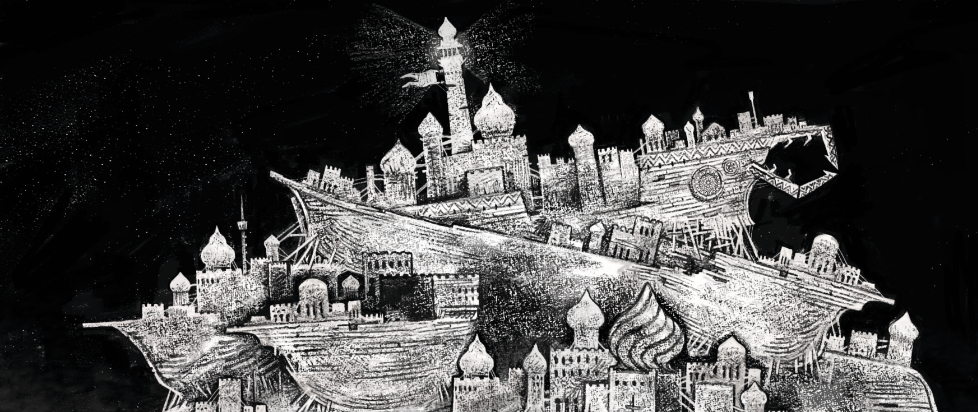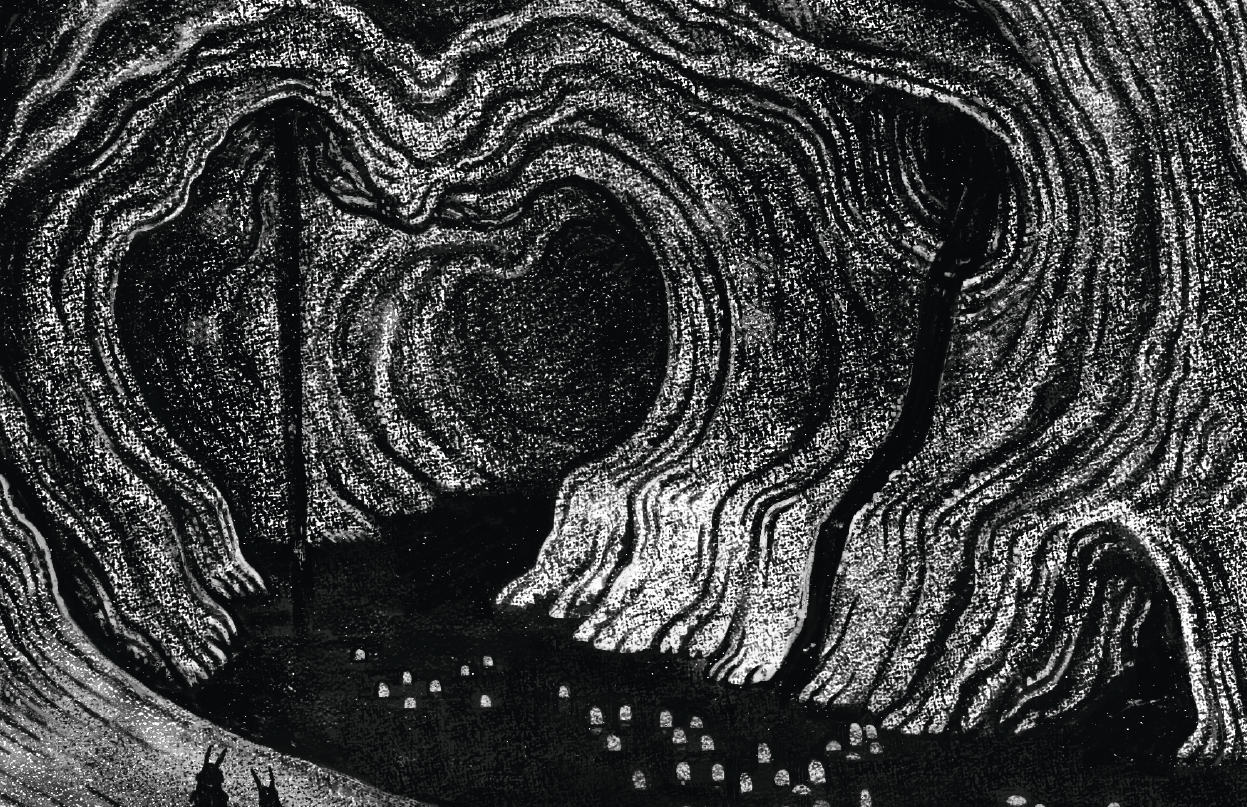
Inventing a World of Insectoid Wonders
This feature is a reprint from Unwinnable Monthly #166. If you like what you see, grab the magazine for less than ten dollars, or subscribe and get all future magazines for half price.
———
This series of articles is made possible through the generous sponsorship of Exalted Funeral. While Exalted Funeral puts us in touch with our subjects, they have no input or approval in the final story.

As the sun sets, a world veiled in darkness comes to life, inhabited by creatures of a fantastical nature. Welcome to Settlers of a Dead God, a tabletop RPG that transports players to an otherworldly universe, the decaying body of a celestial being. The person behind this interesting invention, a role-playing game enthusiast with a knack for adventure design, embarked on a bold and thrilling world-building journey, culminating in a realm dominated by insects and the enigmatic remnants of a deceased deity. For this entry of Funeral Rites, we’ll be delving into the mind of creator Eduardo Carabaño, exploring the history, philosophy, inspirations and design processes that carried Settlers of a Dead God from inception to publication.
For several years, Carabaño honed his RPG design skills by crafting adventures for a tight-knit group of dedicated players, but an insatiable desire for more drove him to envision an entirely new world, one far removed from traditional high fantasy settings. The ambition to forge a realm uniquely his own led to an intriguing and unconventional universe brimming with insectoid wonders. While at the outset, the designer intended this creation to be a private playground for his gaming group, as the scope slowly expanded, he realized that other RPG enthusiasts might enjoy the mysterious world that eventually became Settlers of a Dead God. Taking to a variety of different social media platforms, Carabaño integrated himself into a thriving community of independent authors, always eager to lend a helping hand. “There’s a huge community that is always willing to help,” Carabaño explains. “I contacted François Licata because I found his art in Artstation. He is from Belgium and I have to say that he has been key in the development of the game.”

Settlers of a Dead God presents players with intriguing questions that challenge their beliefs and perceptions about the world around them. Central to the game is the enigma of the eponymous dead god, its true nature shrouded in mystery. Settlers of a Dead God contemplates the varying interpretations of the dead god’s origin, a theme that seamlessly intertwines religion and political conflict, providing a lush backdrop for players to explore. “The game is about a dead corpse and there are lots of different interpretations of its origin,” the designer notes. “Some religions believe it’s a dead god, another religion believes the god is alive, some other people believe it’s not even a god. I wanted to bring the idea of religion and political conflict into the game.” This dynamic exploration shapes the narrative, revealing the multifaceted nature of faith and the complexities of belief systems.
The game also gives players a unique opportunity to engage with the world itself as a central concept. Breaking away from traditional high fantasy landscapes, Carabaño ingeniously crafted the world within a vast corpse. Mountains made of flesh, forests of hair and lakes composed of cornea invite players to embark upon a wild and immersive journey through a realm like no other. “I just wanted to make the world a characteristic and different concept, so I built it inside of a corpse,” Carabaño explains. “The possibilities are endless.”
When it comes to conception, Settlers of a Dead God features an eclectic array of inspirations. With all of their strange and unusual characteristics, the designer’s curiosity about insects provided the creative impetus behind the game. Seeking to dispel the notion that insects are totally different from us, the game portrays them as entities that have more in common with human beings than you might expect. “I have always been very curious about insects,” Carabaño says. “They are so different from other animals that I find them fascinating and intriguing. My idea was to show people that insects are not so different from us than we think.”

As for the rules and systems of play, Settlers of a Dead God started with Carabaño’s passion for diverse and compelling playable classes. Fueled by this interest, the idea of insectoid creatures as potential protagonists emerged, followed by the concept of an enormous corpse as the setting, a key element that offers ample resources and sparks considerable conflict. With the core ideas laid out, the writing process commenced, resulting in a comprehensive world, complete with species, factions, cities and of course the unexplored interior of the corpse.
According to Carabaño, the whole endeavor came to life in written form over the course of about six months. In order to lend visuals to this imaginative world, Carabaño collaborated with a talented artist, Licata, whose dark fantasy style wonderfully complemented the game’s aesthetic, enriching the player experience with captivating illustrations. Despite facing a few delays, the wait ultimately proved to be worthwhile, as the imagery breathed life into the game. “When he started drawing, his art adapted to my ideas,” Carabaño points out. “He has some kind of a dark fantasy style that I really love.”
Crafting the world in Settlers of a Dead God proved both challenging and exhilarating for Carabaño. The process began with the creation of several playable insect species including beetles, worms and wasps. The designer then went about establishing a perfect habitat for these insectoid settlers, leading him to conceptualize the vast corpse. This imaginative foundation opened a treasure trove of possibilities, dividing powerful groups based on the body parts they inhabit, creating religions influenced by their interpretations of the corpse’s origin and charting unexplored regions within its interior. This world-building extended to the development of insectoid societies, drawing parallels to human civilizations. As he pondered the concept of humans evolving from early primates, the designer playfully considered the alternative, a world where insects held the potential to evolve into complex beings, much like their human counterparts.

The game is based on Old-School Essentials, but Settlers of a Dead God contains custom rules for exploring the corpse’s interior, complete with radioactivity, perils and stress mechanics, all of which result in a dangerous and thrilling adventure. This balance of familiar mechanics with creative additions makes the game a unique experience. “The insects have some funny rules on skills or how stress can affect them,” the designer exclaims. “Yes, insects can be stressed too!” Starting with the flexible OSE, the designer chose a streamlined, approachable framework that welcomes both veterans and newcomers to the RPG world. The simplicity and also lethality of OSE perfectly aligned with the designer’s vision, allowing him to focus on world-building and storytelling. This decision allows players to immerse themselves in a universe removed from the familiar trappings of high fantasy. Ensuring internal consistency in the game world was paramount, so Carabaño meticulously crafted a history brimming with plausible explanations, but he also gave the Game Master sufficient freedom to modify and shape the narrative as needed. Tables for generating cities and exploring the origin of the dead god empowers GMs to mold the lore while preserving overall coherence.
Having finally completed Settlers of a Dead God, the designer set his sights on finding a suitable publisher for the game. Enter at this point Exalted Funeral, an RPG indie distributor which is renowned for their support, guidance and keen eye for high quality projects. The partnership with Exalted Funeral ensured that Settlers of a Dead God received the best possible post-launch treatment, opening doors to a much wider audience than Carabaño could have discovered on his own. “They have been amazing from the very beginning with all their help, orientation and editing,” he remarks. “I can’t say enough how helpful they’ve been in developing the game. For me, they were from the very beginning my first option as a publisher.”

The response to Settlers of a Dead God so far has been overwhelmingly positive, with players praising this singular world, rich narrative and engaging gameplay mechanics. From the designer’s intimate gaming group to the broader RPG community, folks have been embracing Settlers of a Dead God with enthusiasm. While the positive feedback has been encouraging, the designer humbly acknowledges the challenge of meeting expectations, but he remains hopeful that Settlers of a Dead God inspires players to explore the boundaries of their imagination and craft universes of their own. “I hope that anyone who gets the game enjoys reading and playing it and also gives inspiration to other people to create new worlds.”
Settlers of a Dead God stands as a testament to the potential of the tabletop RPG to continue crafting unique worlds. Its enthralling universe, complemented by expressive artwork and innovative gameplay mechanics, has already captured the hearts of players worldwide. The journey of a first-time designer exploring insectoid wonders and a corpse made of mysteries has unveiled an exceptional adventure that offers the world in this book to all those looking for a fresh and interesting experience. As the game enthralls players and leaves a lasting impact, Settlers of a Dead God serves as a shining example of the limitless possibilities of the tabletop RPG.
* * *
Read more at the development blog. Settlers of a Dead God
is available now at Exalted Funeral!
———
Justin Reeve is an archaeologist specializing in architecture, urbanism and spatial theory, but he can frequently be found writing about videogames, too. You can follow him on Twitter @JustinAndyReeve.




